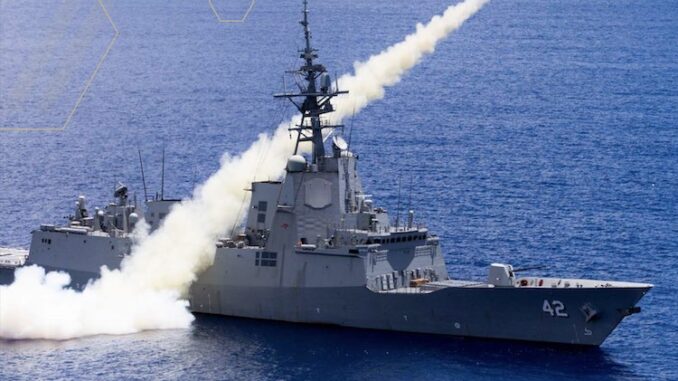
Australia’s Navy is set to become much larger and more lethal in response to “strategic circumstances”, but concerns raised over training of skilled local workforce and recruitment of Defence personnel, writes Chief Editor Nicholas Dynon.
20 February saw the release of the Australian Government’s response to the Enhanced Lethality Surface Combatant Fleet independent analysis, earmarking a more than doubling of the Royal Australian Navy’s (RAN) surface combatant fleet.
Commissioned in response to the 2023 Defence Strategic Review, the independent analysis was led by Vice Admiral William Hilarides, USN (Retd), Ms Rosemary Huxtable, AO, PSM and Vice Admiral Stuart Mayer, AO, RAN.
“Our strategic circumstances require a larger and more lethal surface combatant fleet, complemented by a conventionally-armed, nuclear-powered submarine fleet,” stated the announcement by Defence Minister Richard Marles and Minister for Defence Industry Pat Conroy.
“Navy’s future fleet will be integral to ensure the safety and security of our sea lines of communication and maritime trade, through operations in our immediate region,” said Ministers Marles and Conroy. “This fleet will constitute the largest number of surface combatants since WWII.”
The independent analysis emphasised the need for “immediate action” to boost the RAN’s air defence, long-range strike, presence and anti-submarine warfare capabilities. This translates into a future surface combatant fleet set to comprise:
- Three Hobart class air warfare destroyers with upgraded air defence and strike capabilities
- Six Hunter class frigates to boost Navy’s undersea warfare and strike capabilities
- Eleven new general purpose frigates to provide maritime and land strike, air defence and escort capabilities
- Six new Large Optionally Crewed Surface Vessels (LOSVs) to increase the RAN’s long-range strike capacity
- Six remaining Anzac class frigates with the two oldest ships to be decommissioned as per their planned service life.
25 minor war vessels will also join the fleet to contribute to civil maritime security operations, including six Offshore Patrol Vessels (OPVs).
The Hunter class frigates will be built at the Osborne shipyard in South Australia, and will be followed by the replacement of the Hobart class destroyer. The Hobart destroyers will be upgraded at Osborne with the latest US Navy Aegis combat system.
“Land forces historically have played and continue to play, a major role in conflicts and this capital spending on frigates and submarines must not be at the expense of the Australian Army which also needs the equipment, technology and troops to meet the nation’s needs.”
The new general purpose frigate will be accelerated to replace the Anzac frigates, which results in the Transition Capability Assurance (TransCAP) upgrades no longer being required.
The eight new general purpose frigates to be built at the Henderson precinct will also enable a pathway for the building of six new Large Optionally Crewed Surface Vessels in Western Australia.
An additional $1.7 billion in budget will be injected over the Forward Estimates and $11.1 billion over the next decade in Defence to deliver on the fleet expansion. This is on top of the additional $30.5 billion to Defence’s Integrated Investment Program out to 2032-33.
“This plan ensures Navy’s future fleet can meet our strategic circumstances by delivering a larger and more lethal fleet sooner and secures the future of naval shipbuilding in Australia, supporting 3,700 direct jobs over the next decade and thousands of indirect jobs for decades to come,” said Minister Conroy.
But according to the opposition Liberal Party, Canberra’s plans a superficial and riddled with serious flaws.
“The Albanese Government talks up larger ships and a larger fleet but there is no larger strategy and the money in the forward estimates doesn’t cover the cuts that Labor has already made to Defence,” states Liberal MP Alex Hawkes’ website. “Under Labor’s plan, we won’t see a ship in the water until 2031.”
Canberra has reiterated that an updated Naval Shipbuilding and Sustainment Plan will be released this year.
AIDN pushes for Defence Industry
The Australian Industry & Defence Network (AIDN) welcomed the release of the Surface Combatant Ship Review (SCSR), stating that it will allow the Australian Maritime Industry, and those wishing to be part of it, to start planning.
However, the Network is critical of the government’s plan for initial shipbuilding to occur overseas, and it called for a focus on the training of skilled workers needed in South Australia and Western Australia.
“Whilst AIDN accepts the need for urgency for these ships to strengthen the Royal Australian Navy (RAN), yesterday’s announcement to undertake the initial construction of yet to be selected vessels in a foreign yard, will require the Albanese Government to ensure that Australian Industry is also designed into this build,” it said.
“If the Albanese Government does not mandate this activity, then our local Maritime Defence Industry will find itself excluded from the opportunity to further invest in the much-needed skills, industrial manufacturing and regional jobs Australia needs, and this cannot be allowed to occur.”
RSL raises recruitment concerns
The Returned & Services League of Australia (RSL) similarly welcomed the announcement of the more than doubling of the Navy’s combat fleet, but it has “questioned the commitment to wider Defence readiness and is concerned that the Army has been neglected in the overall strategic upgrade.”
According to RSL Australia National President Greg Melick, the public version of the review appeared a sensible and well-considered approach to deliver a more capable surface fleet for the Royal Australian Navy.
“The RSL particularly welcomes the decision to introduce up to 11 general purpose frigates that will be able to be employed in a range of open ocean and coastal operations,” he said. “The introduction of optionally uncrewed ships is also welcome and timely as we watch the increasing war-time use of uncrewed ships in the Black Sea during the Ukraine conflict.”
According to Melick, a key element of the success of the plan is the recruitment, training and retention of the officers and sailors for the Navy.
“The RSL, like many observers, is very concerned about the difficulties the Australian Defence Force has in recruitment,” he continued. “This must be a matter of utmost priority to address.”
“While we welcome the increased Navy spending, we remain concerned at the impact this may have on Army expenditure. Land forces historically have played and continue to play, a major role in conflicts and this capital spending on frigates and submarines must not be at the expense of the Australian Army which also needs the equipment, technology and troops to meet the nation’s needs.
“We must ensure that we’re not ‘robbing Peter to pay Paul’ by removing needed funding from the Army to pay for the Navy upgrade. Both service arms require additional resources.
“Australia also needs to quickly upgrade its nuclear industry and capabilities to support and enhance the AUKUS submarine program and urgently redevelop local industries to provide the ADF with the necessary logistic reserves including ammunition, spare parts, and strategic fuel reserves to overcome supply chain issues.









